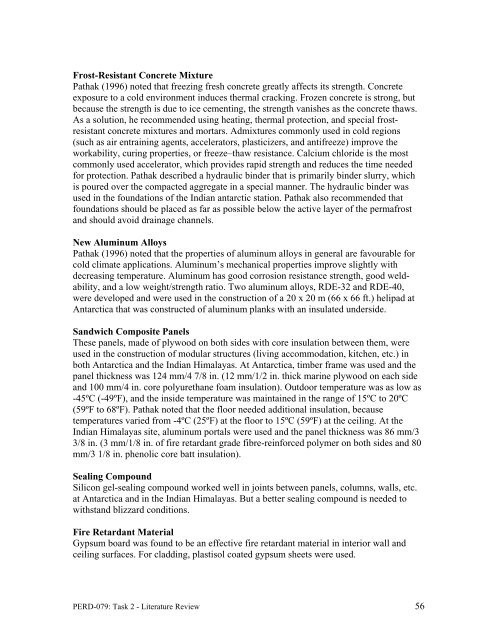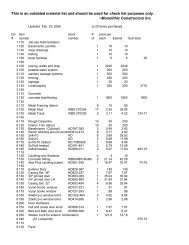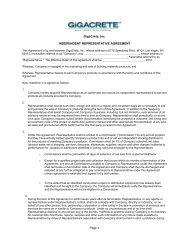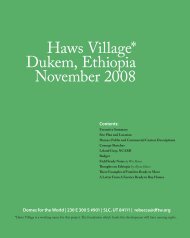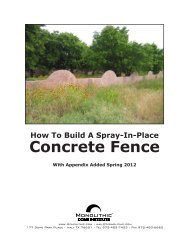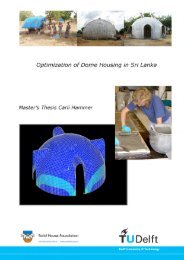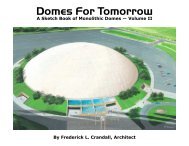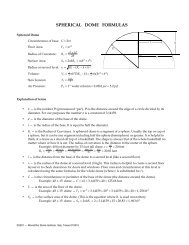Literature Review on Building Envelope, Heating and ... - Beeshive.org
Literature Review on Building Envelope, Heating and ... - Beeshive.org
Literature Review on Building Envelope, Heating and ... - Beeshive.org
You also want an ePaper? Increase the reach of your titles
YUMPU automatically turns print PDFs into web optimized ePapers that Google loves.
Frost-Resistant C<strong>on</strong>crete Mixture<br />
Pathak (1996) noted that freezing fresh c<strong>on</strong>crete greatly affects its strength. C<strong>on</strong>crete<br />
exposure to a cold envir<strong>on</strong>ment induces thermal cracking. Frozen c<strong>on</strong>crete is str<strong>on</strong>g, but<br />
because the strength is due to ice cementing, the strength vanishes as the c<strong>on</strong>crete thaws.<br />
As a soluti<strong>on</strong>, he recommended using heating, thermal protecti<strong>on</strong>, <strong>and</strong> special frostresistant<br />
c<strong>on</strong>crete mixtures <strong>and</strong> mortars. Admixtures comm<strong>on</strong>ly used in cold regi<strong>on</strong>s<br />
(such as air entraining agents, accelerators, plasticizers, <strong>and</strong> antifreeze) improve the<br />
workability, curing properties, or freeze–thaw resistance. Calcium chloride is the most<br />
comm<strong>on</strong>ly used accelerator, which provides rapid strength <strong>and</strong> reduces the time needed<br />
for protecti<strong>on</strong>. Pathak described a hydraulic binder that is primarily binder slurry, which<br />
is poured over the compacted aggregate in a special manner. The hydraulic binder was<br />
used in the foundati<strong>on</strong>s of the Indian antarctic stati<strong>on</strong>. Pathak also recommended that<br />
foundati<strong>on</strong>s should be placed as far as possible below the active layer of the permafrost<br />
<strong>and</strong> should avoid drainage channels.<br />
New Aluminum Alloys<br />
Pathak (1996) noted that the properties of aluminum alloys in general are favourable for<br />
cold climate applicati<strong>on</strong>s. Aluminum’s mechanical properties improve slightly with<br />
decreasing temperature. Aluminum has good corrosi<strong>on</strong> resistance strength, good weldability,<br />
<strong>and</strong> a low weight/strength ratio. Two aluminum alloys, RDE-32 <strong>and</strong> RDE-40,<br />
were developed <strong>and</strong> were used in the c<strong>on</strong>structi<strong>on</strong> of a 20 x 20 m (66 x 66 ft.) helipad at<br />
Antarctica that was c<strong>on</strong>structed of aluminum planks with an insulated underside.<br />
S<strong>and</strong>wich Composite Panels<br />
These panels, made of plywood <strong>on</strong> both sides with core insulati<strong>on</strong> between them, were<br />
used in the c<strong>on</strong>structi<strong>on</strong> of modular structures (living accommodati<strong>on</strong>, kitchen, etc.) in<br />
both Antarctica <strong>and</strong> the Indian Himalayas. At Antarctica, timber frame was used <strong>and</strong> the<br />
panel thickness was 124 mm/4 7/8 in. (12 mm/1/2 in. thick marine plywood <strong>on</strong> each side<br />
<strong>and</strong> 100 mm/4 in. core polyurethane foam insulati<strong>on</strong>). Outdoor temperature was as low as<br />
-45ºC (-49ºF), <strong>and</strong> the inside temperature was maintained in the range of 15ºC to 20ºC<br />
(59ºF to 68ºF). Pathak noted that the floor needed additi<strong>on</strong>al insulati<strong>on</strong>, because<br />
temperatures varied from -4ºC (25ºF) at the floor to 15ºC (59ºF) at the ceiling. At the<br />
Indian Himalayas site, aluminum portals were used <strong>and</strong> the panel thickness was 86 mm/3<br />
3/8 in. (3 mm/1/8 in. of fire retardant grade fibre-reinforced polymer <strong>on</strong> both sides <strong>and</strong> 80<br />
mm/3 1/8 in. phenolic core batt insulati<strong>on</strong>).<br />
Sealing Compound<br />
Silic<strong>on</strong> gel-sealing compound worked well in joints between panels, columns, walls, etc.<br />
at Antarctica <strong>and</strong> in the Indian Himalayas. But a better sealing compound is needed to<br />
withst<strong>and</strong> blizzard c<strong>on</strong>diti<strong>on</strong>s.<br />
Fire Retardant Material<br />
Gypsum board was found to be an effective fire retardant material in interior wall <strong>and</strong><br />
ceiling surfaces. For cladding, plastisol coated gypsum sheets were used.<br />
PERD-079: Task 2 - <str<strong>on</strong>g>Literature</str<strong>on</strong>g> <str<strong>on</strong>g>Review</str<strong>on</strong>g> 56


